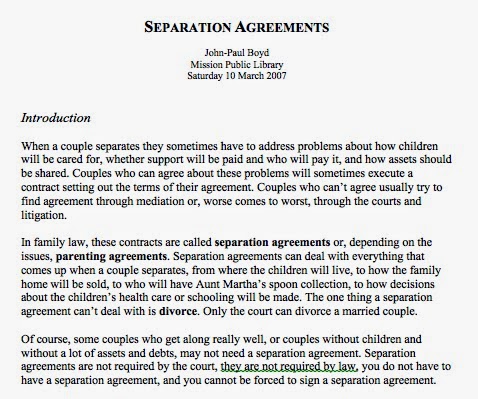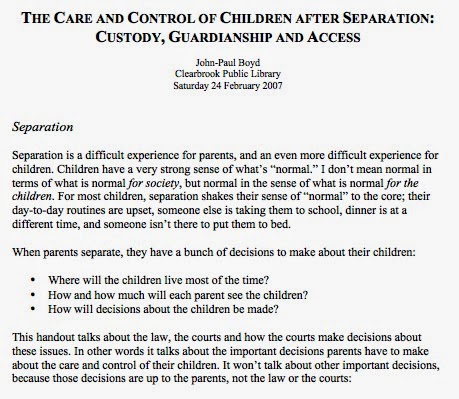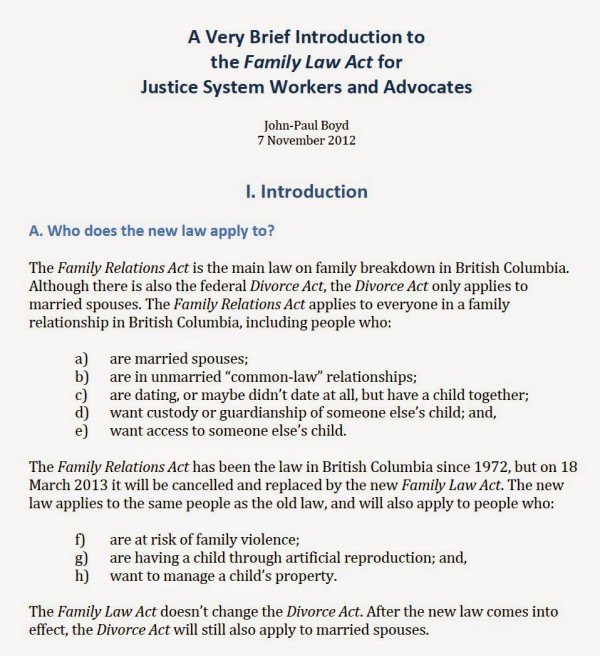DIY A2J 1: Create and Share Plain-Language Information About the Law
Information about the law and dispute resolution processes has been identified as a key barrier to justice in most of the major reports, although in two contradictory senses: a lack of information and a confusing surplus of information. The report of the the Family Justice Working Group (PDF) to the Action Committee on Access to Justice in Civil and Family Matters phrased the problem nicely:
There is a broad consensus in the literature that early information is enormously helpful to separating families, especially — but not only — where spouses are unrepresented. …
Considerable family law information is now available through online and print materials, workshops and courses, in-person government supported information programs, from court staff and in-person and over the phone from both private and publicly funded lawyers. However, it is not always easy for people with family justice problems to access the information they need. The Law Commission of Ontario found there may actually be too much information available and it may not be as effective as it might be. …
The lack of information, or the lack of clear information, may contribute to how people without counsel approach litigation or negotiation. In Self-represented Litigants in Family Law Disputes: Contrasting the Views of Alberta Family Law Lawyers and Judges of the Alberta Court of Queen’s Bench (PDF), the Canadian Research Institute for Law and the Family found that:
- 75% of judges surveyed believed that litigants without counsel always or usually have unrealistically high expectations for the outcome of their cases; and,
- almost 90% of lawyers surveyed believed that such litigants always or usually have unrealistically high expectations of outcome.
It’s not terribly surprising that, perhaps as a result, litigants without counsel also tend to have worse outcomes that litigants with lawyers. In another report, the Institute found that:
- 37% of judges surveyed believed that litigants without counsel achieve worse results on parenting issues than litigants with counsel;
- 50% of of judges believed that litigants without counsel achieve worse results on support issues;
- 56% of of judges believed that litigants without counsel achieve worse results on property division issues; and,
- no judges believed that litigants without counsel achieve better results on any of these issues than litigants with counsel.
One way of improving access to justice for litigants without counsel is to prepare and distribute handouts with clear information about the law and dispute resolution processes. Handouts like this could cover topics ranging from the substantive law on specific issues, management of common litigation tasks, tips for successful mediation or basic settlement strategies. Here, for example, are screen captures of the first pages of some handouts I wrote for a couple of public libraries in British Columbia:


Those handouts were intended for a general audience, with no legal training and little or no legal experience, but they could have been prepared for a more specialized audience. Here, for example, is the first page of some material I prepared specifically for highly skilled non-lawyers helping people through the justice system:

There are all sorts of things you can do with handouts like these. You could leave them in a brochure rack in your reception area; you could give copies to colleagues and to pro bono and community legal clinics; you could give them to social service providers such as youth centres, domestic violence shelters and immigrant settlement agencies. Depending on the views of your local court administrators, you could even leave copies at the court registry.
If you decide to tackle this sort of project, here are some tips and suggestions.
1. Don’t reinvent the wheel and contribute to an information surplus. Look for gaps to fill, and write about those issues.
2. Always use plain language; if you have to use a technical term, be sure to provide a plain language definition. Aim for a reading level most people will be comfortable with.
3. Be neutral and apolitical. Pretend you are writing for an opposing party without counsel.
4. Explain that the information you are providing is general information and is no substitute for proper legal advice. Provide contact information for your local legal clinics and lawyer referral service.
5. Point out areas and issues about which the reader must or should obtain additional information.
6. Remind the reader that the general information provided is not a substitute for specific legal advice.
My personal practice has always been to avoid using information sheets like these to promote myself or my firm. In my view, handouts are more likely to be viewed as trustworthy and credible when they’re not perceived as marketing tools. Handouts that avoid self-promotion are also much more likely to be used by people and organizations other than yourself.
John-Paul Boyd is the executive director of the Canadian Research Institute for Law and the Family. The Institute is a federally-incorporated charity established in 1987 and is affiliated with the University of Calgary.



Comments are closed.